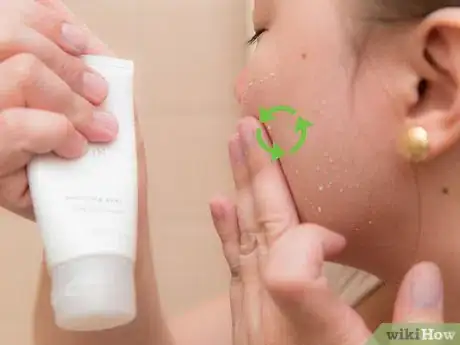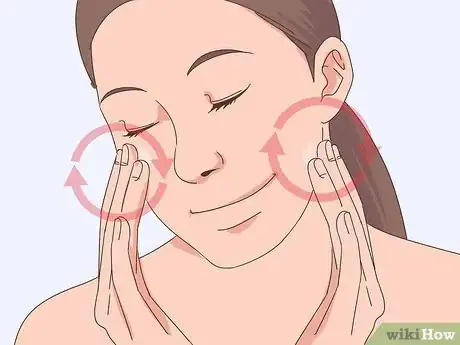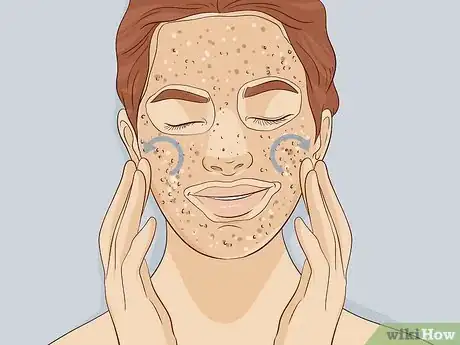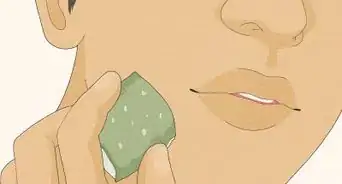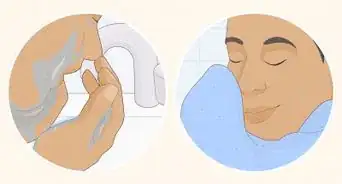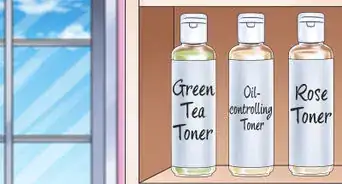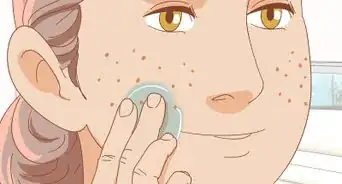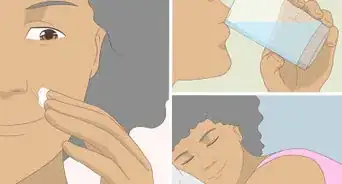This article was co-authored by Mohiba Tareen, MD and by wikiHow staff writer, Megaera Lorenz, PhD. Mohiba Tareen is a board certified Dermatologist and the founder of Tareen Dermatology located in Roseville, Maplewood and Faribault, Minnesota. Dr. Tareen completed medical school at the University of Michigan in Ann Arbor, where she was inducted into the prestigious Alpha Omega Alpha honor society. While a dermatology resident at Columbia University in New York City, she won the Conrad Stritzler award of the New York Dermatologic Society and was published in The New England Journal of Medicine. Dr. Tareen then completed a procedural fellowship which focused on dermatologic surgery, laser, and cosmetic dermatology.
There are 19 references cited in this article, which can be found at the bottom of the page.
wikiHow marks an article as reader-approved once it receives enough positive feedback. This article received 23 testimonials and 88% of readers who voted found it helpful, earning it our reader-approved status.
This article has been viewed 2,001,541 times.
If you dream of having softer, more even skin, you’ve probably thought about incorporating exfoliation into your routine. Exfoliation can smooth out rough skin and may even help some skin treatments work better![1] However, you have to use the right kind of exfoliation for your skin type to get the best results and avoid irritation.[2] It’s best to consult with a dermatologist about how to exfoliate your face. Depending on your needs, there are a number of products and medical procedures you can try.
Steps
Using an Exfoliating Scrub at Home
-
1Pull your hair back. If you have long hair, pull all of it away from your face and secure it with a hair tie. If you have bangs, you may need a headband or pins to hold them back away from your face as well.
- Some exfoliating products are gritty or gunky, so it’s best to avoid getting them in your hair!
-
2Cleanse your face with your usual cleanser. You’ll get the best results if you clean your skin before exfoliating it.[3] Splash on a little lukewarm water and apply your favorite cleanser with your fingertips, then rinse it away with more lukewarm water.[4]
- To prevent irritation, choose a gentle cleanser that’s free of harsh ingredients like alcohol, perfumes, or dyes.
- Don’t use hot water, since it can irritate and dry out your skin.
Advertisement -
3Apply your exfoliant in circular motions with your fingertips. Whatever exfoliant you’re using, have it ready to go. Maybe you decided to make a scrub at home, or maybe you’ve purchased a product at the store. Either way, apply the exfoliating paste to your clean, wet skin. Use your fingertips to gently rub the paste in circular motions over your entire face for about 30 seconds.[5]
- Using your fingertips is the safest way to apply a scrub without irritating your skin. If you use a sponge, brush, or washcloth, keep your strokes very short and light. Don’t rub the exfoliant into your skin!
- Don’t exfoliate if you have open cuts, wounds, a sunburn, or active cold sores.
-
4Rinse the scrub off of your face with lukewarm water. Wash off all the exfoliating paste with warm, not hot, water. Make sure you’ve removed all of the scrub, otherwise your face will be sticky or grainy from the leftover scrub.[6]
- You can use a clean, dry towel to gently blot away excess water, but leave your face a little damp to make your moisturizer more effective.[7]
-
5Smooth on a moisturizer with sunscreen. Right after you’re done exfoliating, while your face is still damp, apply a bit of moisturizer. This will help prevent your skin from drying out, which can cause irritation, breakouts, or peeling.[8] Choose a moisturizer that’s non-comedogenic (won’t clog your pores) and has an SPF (sun protection factor) of at least 30 to prevent sun damage.[9]
- Your skin may be extra sensitive after exfoliating. Choose a gentle moisturizer that’s free of harsh ingredients, like alcohol, dyes, perfumes, or parabens.
-
6Experiment to find the ideal exfoliation schedule. Some skin care specialists advise exfoliating as often as once a day.[10] However, if your skin is dry, sensitive, or easily irritated—or if you’re using particularly strong exfoliants—you may need to do it less often.[11] If you’re not sure how often to exfoliate, ask your doctor or dermatologist.
- Exfoliating too often or too aggressively can be counter-productive, leaving you with damaged, rough, or inflamed skin.
Choosing Exfoliating Products
-
1Examine your skin for oil or dryness to determine your skin type. Everyone’s skin is different, so it’s important to get the best exfoliant for your needs. Look at your skin closely to determine whether you have oily skin, normal skin, or dry skin before buying an exfoliating product. Dry skin is often flaky or itchy, while oily skin can feel greasy or look shiny.[12]
- If your skin tends to have a greasy sheen or is prone to breakouts, especially in the “T-zone” around your nose, forehead, cheeks, and chin, then you probably have oily skin.
- If your skin is dry, flaky, or prone to redness and itching, you may have dry or sensitive skin.
- Many people have a combination of the 2 types in different areas, in which case you may need to use different products on different parts of your face.
-
2Choose products with gentle acids or benzoyl peroxide if your skin is oily or acne-prone. When you buy an exfoliant, check the label and look at the active ingredients to make sure it’s formulated for your skin type. If you have oily or acne-prone skin, choose a product that contains either benzoyl peroxide or salicylic acid.[13]
- These ingredients can help to improve and prevent breakouts. You can also apply an alpha-hydroxy-acid or lactic acid cleanser, which helps remove dead skin cells.
- Use a product with retinoic acid to balance out skin tone and reduce fine lines and wrinkles.[14]
- If you are allergic to aspirin, you should not use any product containing salicylic acid.
-
3Try an electric exfoliating brush for thick, oily skin.[15] Brands like Clarisonic, Foreo, and Anisa have developed tools that can be used to remove the outer layer of dead or uneven skin from your face. These brushes use sonic frequency to remove dirt and debris from your face without irritating your skin.[16]
- Though not as effective as a professional microdermabrasion treatment, these tools are much less expensive. They’re a great alternative to microdermabrasion if you have uneven skin that’s not super dry or sensitive.
- It is important to clean your brush once a week since it comes into contact with the dirt, bacteria, and oils on your face whenever you use it. Check your owner’s manual for instructions on how to clean your brush properly.
-
4Opt for gentle scrubs if you have sensitive or dry skin. If you have sensitive skin, you’ll need to give it more delicate TLC to prevent irritation. Look for products that are labeled as suitable for sensitive skin. Choose a gentle scrub with mild, anti-inflammatory ingredients, such as colloidal oatmeal, instead of harsh chemical exfoliants.[17] These products are good for dry or easily irritated skin, too.
- Avoid scrubs with plastic microbeads, which are harmful to the environment.[18]
Trying Professional Services
-
1Treat yourself to a spa facial. Make exfoliating your face part of a relaxing spa day. Spas offer many dermatological services during facials, from exfoliation to deep cleansing treatments. Every once in a while, enjoy a relaxing day of pampering.[19] While you’re there, treat yourself to a massage, too!
- During a typical spa facial, your aesthetician will cleanse, massage, and moisturize your skin. They may also apply masks or gentle exfoliating treatments.[20]
- If you have any skin concerns, such as unusually dry or sensitive skin, talk to a dermatologist about which spa treatments may be safe and beneficial for you.
- If you want to get a more intensive exfoliating treatment, such as a chemical peel, consult your dermatologist first. It’s usually best to get those kinds of treatments in a dermatologist’s office.
-
2Get professional microdermabrasion for deeper exfoliation. Also referred to as mechanical exfoliation or micro-resurfacing, microdermabrasion uses a mechanical suction tube with an exfoliating tip to get rid of dead or dry layers of skin.[21] It cleans out pores and rejuvenates skin, though the process does need to be repeated every few weeks to maintain the positive effects. Talk to your dermatologist about whether this treatment is right for you.
- Microdermabrasion is a non-invasive treatment that is performed in-office by a dermatologist. On average, a microdermabrasion procedure costs around $136 in the U.S.[22]
- Depending on your needs and the condition of your skin, you might need treatments anywhere from once a week to once a month.[23]
- Don’t do microdermabrasion if you scar easily or have used the medicine isotretinoin within the past 6 months. If you are on any type of acne medication, ask your dermatologist before getting any microdermabrasion treatments.
-
3Try a chemical peel as an alternative to microdermabrasion. If you do not have dry or sensitive skin, you may be a candidate for getting a chemical peel from a dermatologist every 4-6 weeks. Chemical peel solutions contain acids that help to remove dead skin, speed cell regeneration, or both.[24] The top layer of your skin will be red and irritated for a few days after a chemical peel, and then it will begin to heal itself and generate fresh, smooth skin.[25]
- On average, a chemical peel costs around $644 in the U.S. However, the price can vary a great deal depending on factors like the type of peel you’re getting and the doctor’s experience level.[26]
- Chemical peels can be done at light, medium, or deep levels depending on your desired results. Deeper peels take longer to heal.
- Your skin will probably look red for a little while after a chemical peel. Other less common risks include scarring, changes in skin color, and infection. The carbolic acid in deep chemical peels can also cause heart, kidney, or liver damage, so talk to your doctor before trying this treatment.
Expert Q&A
Did you know you can get expert answers for this article?
Unlock expert answers by supporting wikiHow
-
QuestionShould you exfoliate in the morning or at night?
 Mohiba Tareen, MDMohiba Tareen is a board certified Dermatologist and the founder of Tareen Dermatology located in Roseville, Maplewood and Faribault, Minnesota. Dr. Tareen completed medical school at the University of Michigan in Ann Arbor, where she was inducted into the prestigious Alpha Omega Alpha honor society. While a dermatology resident at Columbia University in New York City, she won the Conrad Stritzler award of the New York Dermatologic Society and was published in The New England Journal of Medicine. Dr. Tareen then completed a procedural fellowship which focused on dermatologic surgery, laser, and cosmetic dermatology.
Mohiba Tareen, MDMohiba Tareen is a board certified Dermatologist and the founder of Tareen Dermatology located in Roseville, Maplewood and Faribault, Minnesota. Dr. Tareen completed medical school at the University of Michigan in Ann Arbor, where she was inducted into the prestigious Alpha Omega Alpha honor society. While a dermatology resident at Columbia University in New York City, she won the Conrad Stritzler award of the New York Dermatologic Society and was published in The New England Journal of Medicine. Dr. Tareen then completed a procedural fellowship which focused on dermatologic surgery, laser, and cosmetic dermatology.
FAAD Board Certified Dermatologist
-
QuestionWhat is a good exfoliator for your face?
 Mohiba Tareen, MDMohiba Tareen is a board certified Dermatologist and the founder of Tareen Dermatology located in Roseville, Maplewood and Faribault, Minnesota. Dr. Tareen completed medical school at the University of Michigan in Ann Arbor, where she was inducted into the prestigious Alpha Omega Alpha honor society. While a dermatology resident at Columbia University in New York City, she won the Conrad Stritzler award of the New York Dermatologic Society and was published in The New England Journal of Medicine. Dr. Tareen then completed a procedural fellowship which focused on dermatologic surgery, laser, and cosmetic dermatology.
Mohiba Tareen, MDMohiba Tareen is a board certified Dermatologist and the founder of Tareen Dermatology located in Roseville, Maplewood and Faribault, Minnesota. Dr. Tareen completed medical school at the University of Michigan in Ann Arbor, where she was inducted into the prestigious Alpha Omega Alpha honor society. While a dermatology resident at Columbia University in New York City, she won the Conrad Stritzler award of the New York Dermatologic Society and was published in The New England Journal of Medicine. Dr. Tareen then completed a procedural fellowship which focused on dermatologic surgery, laser, and cosmetic dermatology.
FAAD Board Certified Dermatologist
-
QuestionCan I use any type of honey?
 Laura MartinLaura Martin is a Licensed Cosmetologist in Georgia. She has been a hair stylist since 2007 and a cosmetology teacher since 2013.
Laura MartinLaura Martin is a Licensed Cosmetologist in Georgia. She has been a hair stylist since 2007 and a cosmetology teacher since 2013.
Licensed Cosmetologist
Warnings
- Be sure to consult with a dermatologist before exfoliating if you have a darker skin tone or if you scar easily. Using improper technique could result in skin color changes.[30]⧼thumbs_response⧽
- Some skin products can make your skin more sensitive or more likely to peel, like those with benzoyl peroxide or retinol.[31] Be careful exfoliating if you already use one of these products.⧼thumbs_response⧽
- If you have a mole or discolored spot on your skin that is growing or changing, see a doctor right away to get checked for skin cancer.[32]⧼thumbs_response⧽
References
- ↑ https://health.clevelandclinic.org/5-ways-to-exfoliate-your-skin-without-irritation/
- ↑ https://www.aad.org/public/everyday-care/skin-care-secrets/routine/safely-exfoliate-at-home
- ↑ https://jddonline.com/articles/dermatology/S1545961619P0028X/3
- ↑ https://www.aad.org/public/everyday-care/skin-care-basics/care/face-washing-101
- ↑ https://www.aad.org/public/everyday-care/skin-care-secrets/routine/safely-exfoliate-at-home
- ↑ https://www.aad.org/public/everyday-care/skin-care-secrets/routine/safely-exfoliate-at-home
- ↑ https://www.mayoclinic.org/diseases-conditions/dry-skin/in-depth/moisturizers/art-20044232
- ↑ https://www.aad.org/public/everyday-care/skin-care-secrets/routine/safely-exfoliate-at-home
- ↑ https://www.mayoclinic.org/diseases-conditions/dry-skin/in-depth/moisturizers/art-20044232
- ↑ https://health.clevelandclinic.org/5-ways-to-exfoliate-your-skin-without-irritation/
- ↑ https://www.aad.org/public/everyday-care/skin-care-secrets/routine/safely-exfoliate-at-home
- ↑ https://my.clevelandclinic.org/health/drugs/10981-know-your-skin-type-before-choosing-skin-care-products
- ↑ https://www.aad.org/public/everyday-care/skin-care-secrets/routine/safely-exfoliate-at-home
- ↑ https://health.clevelandclinic.org/5-ways-to-exfoliate-your-skin-without-irritation/
- ↑ https://www.aad.org/public/everyday-care/skin-care-secrets/routine/safely-exfoliate-at-home
- ↑ https://health.clevelandclinic.org/5-ways-to-exfoliate-your-skin-without-irritation/
- ↑ https://www.ncbi.nlm.nih.gov/pmc/articles/PMC3508548/
- ↑ https://www.environment.gov.au/protection/waste-resource-recovery/plastics-and-packaging/plastic-microbeads
- ↑ https://www.aad.org/public/everyday-care/skin-care-secrets/face/spa-facials-okay-for-skin
- ↑ https://www.consumerreports.org/alternative-medicine/spa-safety-tips-massage-manicure-pedicure-facial/
- ↑ https://www.aad.org/public/diseases/cosmetic-treatments/microdermabrasion
- ↑ https://www.plasticsurgery.org/cosmetic-procedures/microdermabrasion/cost
- ↑ https://www.aad.org/public/cosmetic/age-spots-marks/microdermabrasion-faqs
- ↑ Mohiba Tareen, MD. FAAD Board Certified Dermatologist. Expert Interview. 26 March 2020.
- ↑ https://www.mayoclinic.org/tests-procedures/chemical-peel/about/pac-20393473
- ↑ https://www.plasticsurgery.org/cosmetic-procedures/chemical-peel/cost
- ↑ https://dermnetnz.org/topics/contact-reactions-to-cosmetics/
- ↑ Mohiba Tareen, MD. FAAD Board Certified Dermatologist. Expert Interview. 26 March 2020.
- ↑ Mohiba Tareen, MD. FAAD Board Certified Dermatologist. Expert Interview. 26 March 2020.
- ↑ https://www.aad.org/public/everyday-care/skin-care-secrets/routine/safely-exfoliate-at-home
- ↑ https://www.aad.org/public/skin-hair-nails/skin-care/exfoliation
- ↑ https://www.aad.org/public/diseases/cosmetic-treatments/microdermabrasion#faqs
About This Article
To exfoliate your face, try scrubbing it with a mixture of water and baking soda, and letting it sit for 10 minutes before washing it off with warm water and a washcloth. Alternatively, make a scrub by combining 1 tablespoon of white or brown sugar with 2 tablespoons of olive or coconut oil. Massage the scrub onto your face in small circles with a washcloth, then rinse with warm water. When you’re done exfoliating, gently pat your face dry, and apply a moisturizer with sunscreen to keep your skin smooth and protect it from the sun. To learn more, like how to choose a commercial exfoliator with the right ingredients for your skin type, scroll down!





